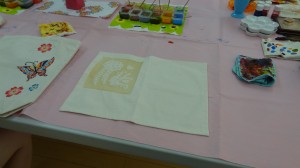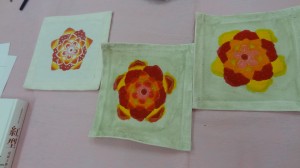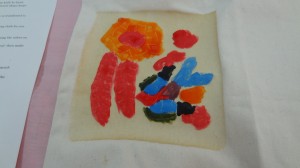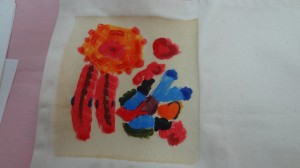Bingata
 I’m currently visiting my sister in Okinawa, Japan and she took me to a class on how to make bingata. I chose to make a bingata place mat so this is what awaited me:
I’m currently visiting my sister in Okinawa, Japan and she took me to a class on how to make bingata. I chose to make a bingata place mat so this is what awaited me:
I didn’t know what “bingata” was (that is link to a Wikipedia article that will explain it better than I will) but it is basically a special way to paint fabrics. The technique came from India and possibly China before trade brought the knowledge to Okinawa during the Ryukyun Kingdom. When the Japanese took over Okinawa, trade changed and they lost the access to the pigments they were used to and had to create new pigments from local items. Those techniques were lost during the Battle of Okinawa during World War 2 so one of the remaining members of the three families allowed from ancient times to produce bingata went to mainland Japan to get the stencils taken by soldiers or collectors. He revived the art with the new stencils and his son is still creating the art in his studio.
What is bingata? you ask. Have you seen those kimonos from before the second World War that have decorations on them? Not the plain ones but the pictures of the very wealthy or royalty wearing flowing kimonos with nature scenes on them? Those scenes are hand painted using the bingata technique. Yes, those huge silk kimonos were hand painted.
 The first step to creating a bingata masterpiece is to cut mulberry paper by hand into delicate shapes which then get pasted on a type of thin lace to hold everything in place. After the stencil is complete, it is laid out over the cloth and a special paste of rice, rice bran, and water is put over the cloth and lace stencil. Then the stencil is lifted off the fabric, leaving the rice-paste where the stencil hadn’t been. Next the pigment is applied and the artist doesn’t need to stay in the lines. In fact, the idea is to paint beyond the lines so every little part is colored. Once the paste is removed, all the paint not on the stenciled area will be removed as well. After the first layer of pigment is done, the cloth is heated (in our case using a hair dryer) until dry and another set of pigment is applied. This type of pigment is used for shading and it is more carefully applied. (The first square on the right shows the first step, the purely painting part, the middle one shows after shading, and the one on the left is the finished product.) After the shading is done, the cloth is heated again before the paste is washed off with the excess paint. It may take a few tries, especially for newcomers, but the paste should come off leaving a delicate design of many shades on the cloth.
The first step to creating a bingata masterpiece is to cut mulberry paper by hand into delicate shapes which then get pasted on a type of thin lace to hold everything in place. After the stencil is complete, it is laid out over the cloth and a special paste of rice, rice bran, and water is put over the cloth and lace stencil. Then the stencil is lifted off the fabric, leaving the rice-paste where the stencil hadn’t been. Next the pigment is applied and the artist doesn’t need to stay in the lines. In fact, the idea is to paint beyond the lines so every little part is colored. Once the paste is removed, all the paint not on the stenciled area will be removed as well. After the first layer of pigment is done, the cloth is heated (in our case using a hair dryer) until dry and another set of pigment is applied. This type of pigment is used for shading and it is more carefully applied. (The first square on the right shows the first step, the purely painting part, the middle one shows after shading, and the one on the left is the finished product.) After the shading is done, the cloth is heated again before the paste is washed off with the excess paint. It may take a few tries, especially for newcomers, but the paste should come off leaving a delicate design of many shades on the cloth.
The teacher had already put down the stencil on the paste and removed the stencil by the time the class started (those steps can take a few days so that was good) and all we had to do was paint the image on the paper. I decided to try and get an unrealistic bird and flower based on the idea of fire.
My sister and I will now have to wait a few days before we can iron our bingata pieces and wash off the paste to see what we created in our first time working with the paints. We both eagerly await the “unveiling” of our creations. Earlier in the class the teacher had mentioned a yellow shading pigment so I had planned on it in my design. No such luck so I had to adapt with darker pigments. We’ll see how it comes out.


